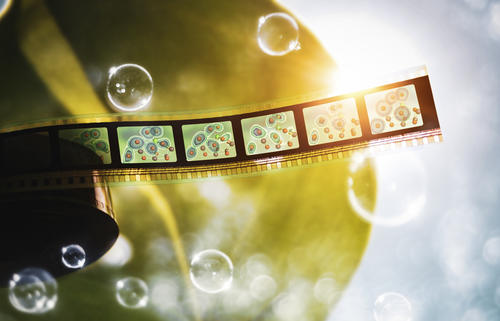SFB 1078 projects A4 and A5 published two papers in Nature about the dynamics of photosystem II
Illustration of photosystem II.
Image Credit: Gregory M Stewart, SLAC National Accelerator Laboratory
Postdoc and former IGK member Rana Hussein, together with PIs Athina Zouni and Holger Dobbek (project A5), have published a paper in Nature elucidating the mechanisms underlying the formation of oxygen during photosynthesis, a mechanism also examined by IGK member Paul Greife and PI Holger Dau (project A4) in a second Nature publication. Together, their work not only deepens our understanding of protein function but paves the way for the clean production of storable energy with artificial photosynthesis via water-splitting processes.
News from May 08, 2023
The conversion of solar energy into atmospheric oxygen (O2) via the splitting of water during photosynthesis occurs in the photosystem II enzyme, a transmembrane protein which is a main focus of SFB 1078 researchers. Within the photoenzyme, water is split into hydrogen ions, electrons, and oxygen in the oxygen-evolving complex (OEC), which transitions between S-states in a catalytic cycle. While the S0, S1, S2, and S3 states have been well characterized, the details of the final reaction step have remained elusive to researchers. This part of the cycle, the S3→S4→S0 transition, is responsible for O2 formation during photosynthetic water oxidation.
The sequence and timing of the S3→S4→S0 transition has been revealed by Bhowmick et al. with serial femtosecond protein crystallography. Using an X-Ray Free-Electron Laser (XFEL), they measured the structural changes of the photoenzyme during the S3→S4→S0 transition of the catalytic cycle. Their results show that after excitation of the S3 state, a tyrosine radical YZ is formed resulting in an early deprotonation event involving Asp61 and Glu65 before progressing to the transient S4 state in the final oxidation event, after which O–O bond formation and O2 release occurs. These results are in agreement with Greife et al., which reveal via time-resolved microsecond Fourier-transform infrared spectroscopy (FTIR) and quantum-chemical calculations the timing of the early deprotonation event and its association with either Asp61 or a pair of residues (Glu65 and Glu312). They are also the first to identify the S4 reactive intermediate as an oxyl-radical state, formerly only postulated to exist by the creator of the S-state cycle paradigm Bessel Kok over 50 years ago. These two studies compliment one another and previous work, providing valuable experimental support for a growing understanding of the mechanisms behind water oxidation.
Bhowmick, A., Hussein, R., Bogacz, I., Simon, P.S., Ibrahim, M., Chatterjee, R., Doyle, M.D., Cheah, M.H., Fransson, T., Chernev, P., Kim, I.-S., Makita, H., Dasgupta, M., Kaminsky, C.J., Zhang, M., Gätcke, J., Haupt, S., Nangca, I.I., Keable, S.M., Aydin, A.O., Tono, K., Owada, S., Gee, L.B., Fuller, F.D., Batyuk, A., Alonso-Mori, R., Holton, J.M., Paley, D.W., Moriarty, N.W., Mamedov, F., Adams, P.D., Brewster, A.S., Dobbek, H., Sauter, N.K., Bergmann, U., Zouni, A., Messinger, J., Kern, J., Yano, J. and Yachandra, V.K. (2023). Structural evidence for intermediates during O2 formation in photosystem II. Nature, doi: 10.1038/s41586-023-06038-z
Greife, P., Schönborn, M., Capone, M., Assunção, R., Narzi, D., Guidoni, L. and Dau, H. (2023). The electron–proton bottleneck of photosynthetic oxygen evolution. Nature, doi: 10.1038/s41586-023-06008-5
